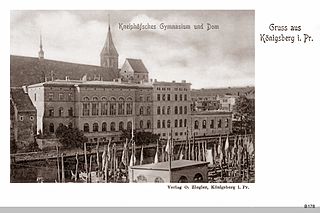
The University of Königsberg was the university of Königsberg in Duchy of Prussia, which was a fief of Poland. It was founded in 1544 as the world's second Protestant academy by Duke Albert of Prussia and charted by the King Sigismund II Augustus. It was commonly known as the Albertina and served as a Protestant counterpart to the Catholic Jagiellonian University in Kraków.

St. Thomas School, Leipzig is a co-educational and public boarding school in Leipzig, Saxony, Germany. It was founded by the Augustinians in 1212 and is one of the oldest schools in the world.

The Friedenspark is an open space of about 20 hectares in the centre of Leipzig, in the district of Zentrum-Südost, located between the Ostplatz to the north and the Russian Memorial Church to the south. The park was opened in 1983, after the secularisation and clearance, under the then East German regime, of the Neuer Johannisfriedhof, which is what the space used to be, and its thorough reconstruction.
The history of the Jews in Königsberg reaches back to the 1530s. By the 20th century Königsberg had one of the larger Jewish communities within the German Reich. The city's Jewish community was eliminated by emigration and then The Holocaust during World War II.

Amalienau was a suburban quarter of western Königsberg, Germany. Its territory is now part of the Tsentralny District of Kaliningrad, Russia.

The Königsberg State and University Library was a combined state library and academic library in Königsberg, East Prussia, Germany. One of the most prestigious libraries of the eastern German Sprachraum, comparable only to the Breslau University Library, in Breslau in Silesia of then southeastern Germany,. Königsberg University's developed since the 16th century out of several smaller libraries. It was destroyed in 1944 during World War II in the invasion by the Soviet Union after which the city was occupied and renamed Kaliningrad.

The Wilhelm-Ernst-Gymnasium is a secondary school on Herderplatz 14 in Weimar, Germany. Founded in 1712 by Duke William Ernest of Saxe-Weimar, it is the oldest school building in the city. Numerous notable figures such as Johann Gottfried Herder, Johann Heinrich Voss, Friedrich Wilhelm Riemer and Johann Karl August Musäus studied here. It is a designated historic site and is one of the few secular buildings of the pre-classical period still remaining in Weimar. It is prominently located in the urban center and is one of three sites forming the UNESCO World Heritage Site Classical Weimar, created in 1998.
The Burgschule or Oberrealschule auf der Burg was a secondary school (Oberrealschule) located originally in central Königsberg, Germany, and later in the suburban Amalienau quarter. It was the fourth oldest school in the city, behind Altstadt Gymnasium, Kneiphof Gymnasium, and Löbenicht Realgymnasium.

Altstadt Gymnasium was a German secondary school in the Altstadt quarter of Königsberg, Germany.

Kneiphof Gymnasium was a gymnasium in the Kneiphof quarter of Königsberg, Germany.
Löbenicht Realgymnasium was a gymnasium in the Löbenicht quarter of Königsberg, Germany.

The Wilhelmsgymnasium, originally the Königliches Wilhelms-Gymnasium, was a gymnasium in the Tragheim quarter of Königsberg, Germany.

The Kunstakademie Königsberg was a visual arts school in Königsberg, Germany. It focused on genre works, landscape art, and marine art, especially of East Prussia, as well as sculpture and architecture. It regularly consisted of 8 teachers and 40–50 students.

Ernst August Hagen was a Prussian writer on art and novelist. He taught at Königsberg University and was the first Prussian scholar to hold a teaching chair in Art history and Aesthetics.

For over 200 years, the Stadttheater Königsberg in Königsberg was one of the most respected theatres in Prussia and in the German Empire.
Events from the year 1797 in Germany.














